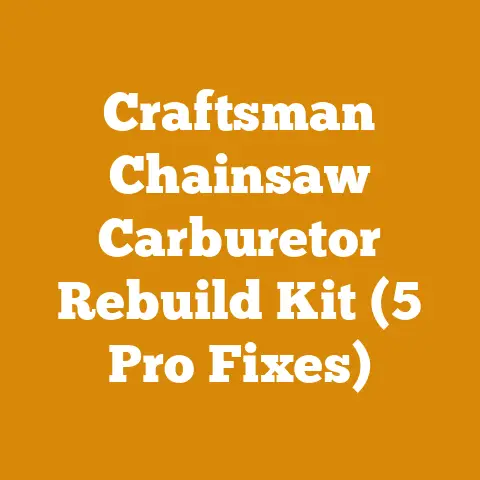Jonsered CS2238S Maintenance Tips (5 Pro Hacks for Longevity)
Unleash the Beast: 5 Pro Hacks to Make Your Jonsered CS2238S Roar for Years (And Save You a Fortune!)
The Jonsered CS2238S. It’s a workhorse. A dependable partner in the woods. And, let’s be honest, a bit of an investment. I remember the day I bought mine. I’d been saving for months, picturing myself felling trees like a seasoned lumberjack. The reality was a little less glamorous – mostly bucking firewood for the winter – but the Jonsered handled it all. What I didn’t picture was the potential cost of neglecting proper maintenance. A seized engine, a dull chain, a worn-out clutch – these aren’t just inconveniences; they’re wallet-draining disasters waiting to happen.
That’s why I’m sharing my hard-earned wisdom. Over the years, I’ve learned a few tricks to keep my CS2238S running smoothly and efficiently, and I’m going to show you how to do the same. These aren’t just your run-of-the-mill maintenance tips; these are pro hacks designed to maximize the lifespan of your chainsaw and minimize your running costs. Think of it as preventative medicine for your Jonsered – a small investment now that will pay dividends in the long run.
Hack #1: The Fuel Formula for Forever: Optimizing Oil Mix and Storage to Prevent Engine Seizures
The heart of any two-stroke engine, like the one in your CS2238S, is the fuel mixture. Get it wrong, and you’re asking for trouble. I’ve seen firsthand the damage that incorrect fuel mixtures can inflict. A buddy of mine, convinced he could save a few bucks, started using a cheaper oil and guessing at the ratio. Within a few months, his chainsaw was sputtering, losing power, and eventually seized completely. The repair bill? More than he would have spent on quality oil in years!
Why it Matters:
- Lubrication is Key: Two-stroke engines rely on the oil mixed with the fuel to lubricate the internal components. Insufficient lubrication leads to excessive friction, overheating, and ultimately, engine seizure.
- Fuel Quality Matters: Ethanol-blended fuels can absorb water, leading to corrosion and fuel system issues. Old fuel can also degrade, forming varnish that clogs carburetors and fuel lines.
- Incorrect Ratio = Disaster: Too little oil, and you risk engine damage. Too much oil, and you’ll experience excessive smoke, carbon buildup, and reduced performance.
The Pro Hack:
- Use High-Quality Two-Stroke Oil: Don’t skimp here! Invest in a reputable brand of two-stroke oil specifically formulated for air-cooled engines. Look for oils with JASO FD or ISO-L-EGD ratings, which indicate superior lubrication and detergency. I personally prefer synthetic blends, as they offer better protection against wear and tear. I’ve found the extra cost is negligible compared to the potential savings in repairs.
- Adhere to the Recommended Oil-to-Fuel Ratio: The Jonsered CS2238S typically requires a 50:1 fuel-to-oil ratio. This means 50 parts gasoline to 1 part oil. Use a dedicated measuring container to ensure accurate mixing. Don’t eyeball it! A slight deviation can have significant consequences.
- Mix Fuel Fresh: Only mix the amount of fuel you anticipate using within a month. Ethanol-blended fuels degrade quickly. If you’re not planning on using your chainsaw for an extended period, drain the fuel tank completely.
- Use Fuel Stabilizer: If you must store fuel for longer than a month, add a fuel stabilizer to prevent degradation. This will help prevent varnish buildup and keep your fuel system clean.
- Store Fuel Properly: Store your mixed fuel in a clean, airtight container in a cool, dark place. Avoid storing fuel in direct sunlight or extreme temperatures.
Data-Driven Insights:
- Two-Stroke Oil Market: According to a report by Grand View Research, the global two-stroke engine oil market was valued at USD 3.7 billion in 2022 and is expected to grow at a CAGR of 3.5% from 2023 to 2030. This growth is driven by the increasing demand for two-stroke engines in various applications, including chainsaws. The market is segmented by type (mineral, synthetic, semi-synthetic) and application (automotive, industrial, marine, etc.).
- Fuel Stabilizer Market: The fuel stabilizer market is also experiencing growth, driven by the increasing awareness of the importance of fuel quality. A report by MarketsandMarkets projects the fuel stabilizer market to reach USD 1.1 billion by 2027.
- Cost Savings: Engine rebuilds due to improper lubrication can easily cost upwards of $300-$500, including parts and labor. Investing in quality oil and fuel stabilizer, which might cost an extra $20-$30 per year, can prevent this costly expense.
My Experience:
I learned this lesson the hard way. Back in my early days of chainsawing, I used to buy the cheapest two-stroke oil I could find. I figured, “Oil is oil, right?” Wrong! My chainsaw started running rough, losing power, and eventually, the piston scored. The repair bill was a wake-up call. Now, I only use high-quality synthetic oil and always mix my fuel fresh. My chainsaw runs smoother, starts easier, and I haven’t had a major engine problem since.
Hack #2: The Razor’s Edge: Mastering Chain Sharpening and Maintenance for Peak Performance and Safety
A dull chainsaw is a dangerous chainsaw. It requires more force to cut, increasing the risk of kickback and operator fatigue. It also wastes fuel and puts unnecessary strain on the engine. I’ve seen guys struggling with dull chains, forcing the saw through the wood, producing clouds of sawdust, and barely making any progress. It’s not only inefficient but also incredibly frustrating.
Why it Matters:
- Safety First: A sharp chain bites into the wood cleanly and efficiently, reducing the risk of kickback.
- Efficiency and Performance: A sharp chain cuts faster, requires less effort, and consumes less fuel.
- Extending Chain Life: Regular sharpening prevents excessive wear and tear on the chain, extending its lifespan.
The Pro Hack:
- Sharpen Regularly: Don’t wait until your chain is completely dull. Sharpen it every time you refuel or after every few hours of use, depending on the type of wood you’re cutting.
- Use the Right Tools: Invest in a quality chainsaw sharpening kit that includes a file guide, round files, and a flat file. A file guide helps maintain the correct filing angle and depth, ensuring consistent sharpening.
- Master the Filing Technique: Learn the proper filing technique for your specific chain type. Maintain the correct angle, depth, and stroke direction. There are plenty of online tutorials and videos to guide you.
- Check the Depth Gauges: The depth gauges (or rakers) control the amount of wood each cutter takes. As you sharpen the cutters, the depth gauges will need to be filed down to maintain the correct height. Use a depth gauge tool and a flat file to adjust the depth gauges according to the manufacturer’s recommendations.
- Clean and Lubricate the Chain: After each use, clean the chain with a brush and solvent to remove sawdust and debris. Lubricate the chain with chainsaw chain oil to reduce friction and prevent rust.
- Proper Chain Tension: Ensure the chain tension is correct. A chain that’s too loose can derail, while a chain that’s too tight can overheat and break.
Data-Driven Insights:
- Chainsaw Chain Market: The global chainsaw chain market is a significant market, driven by the widespread use of chainsaws in various industries. According to a report by Research and Markets, the global chainsaw chain market is expected to grow at a CAGR of 3.2% from 2023 to 2028. This growth is fueled by the increasing demand for chainsaws in forestry, agriculture, and construction.
- Sharpening Costs: Professional chainsaw sharpening typically costs between $10 and $20 per chain. Sharpening your own chain can save you significant money over time. A good sharpening kit costs around $30-$50 and will last for years.
- Fuel Savings: A sharp chain can improve fuel efficiency by as much as 20%. This translates to significant savings over the lifespan of the chainsaw, especially for those who use their chainsaw frequently.
My Experience:
I used to be intimidated by chainsaw sharpening. I thought it was a complex and difficult skill to master. But after watching a few tutorials and practicing on an old chain, I realized it’s not as hard as it seems. Now, I sharpen my own chains regularly, and it makes a huge difference in performance and safety. Plus, I save a lot of money by not having to take my chains to a professional sharpener. I recall one time I was cutting some fallen oak limbs after a storm. I got lazy and didn’t sharpen the chain. By the end of the day, I was exhausted, the saw was bogging down, and the cuts were ragged. The next day, I sharpened the chain, and it was like using a brand-new saw. The difference was night and day.
Hack #3: The Oiling Advantage: Optimizing Chain and Bar Lubrication to Minimize Wear and Tear
Proper lubrication of the chain and bar is essential for smooth cutting, reduced friction, and extended component life. Neglecting lubrication can lead to premature wear of the chain, bar, and sprocket, resulting in costly repairs or replacements. I’ve seen chainsaw bars worn down to almost nothing because the user didn’t bother to check the oil level or use the correct type of oil.
Why it Matters:
- Reduced Friction: Chain oil reduces friction between the chain, bar, and sprocket, allowing the chain to move smoothly and efficiently.
- Cooling: Chain oil helps to dissipate heat generated by friction, preventing overheating and damage to the components.
- Preventing Wear: Proper lubrication minimizes wear and tear on the chain, bar, and sprocket, extending their lifespan.
The Pro Hack:
- Use the Right Chain Oil: Use a high-quality chainsaw chain oil specifically formulated for this purpose. Avoid using motor oil or other substitutes, as they may not provide adequate lubrication or may damage the components. I prefer using bar and chain oil that contains tackifiers, which help the oil adhere to the chain and bar, providing better lubrication.
- Check the Oil Level Regularly: Check the chain oil level before each use and refill as needed. Don’t let the oil reservoir run dry.
- Adjust the Oil Flow: Most chainsaws have an adjustable oil flow. Adjust the oil flow according to the type of wood you’re cutting and the operating conditions. For harder woods or warmer weather, increase the oil flow. For softer woods or cooler weather, decrease the oil flow.
- Clean the Oiler: Periodically clean the oiler to ensure proper oil flow. Remove any debris or sawdust that may be clogging the oiler.
- Inspect the Bar Regularly: Inspect the chainsaw bar regularly for wear and damage. Check the bar rails for burrs or grooves. If the bar is worn or damaged, replace it.
- Flip the Bar: Flip the chainsaw bar periodically to even out wear on both sides.
Data-Driven Insights:
- Chain Oil Market: The global chainsaw chain oil market is a significant market, driven by the widespread use of chainsaws in various industries. The market is segmented by type (mineral, synthetic, bio-based) and application (forestry, agriculture, construction, etc.).
- Cost of Bar and Chain Replacement: Replacing a worn-out chainsaw bar and chain can cost anywhere from $50 to $150, depending on the size and type of the chainsaw. Proper lubrication can significantly extend the lifespan of these components, saving you money in the long run.
- Biodegradable Chain Oil: There is a growing trend towards using biodegradable chain oil, which is more environmentally friendly. While biodegradable oils may be slightly more expensive, they are a more sustainable option.
My Experience:
I once had a chainsaw bar wear out prematurely because I wasn’t paying attention to the oil level. I was cutting a lot of firewood that winter, and I got complacent about checking the oil. One day, I noticed the chain was smoking and the bar was getting hot. I checked the oil reservoir, and it was bone dry! The bar was already damaged, and I had to replace it. Now, I make it a habit to check the oil level every time I refuel, and I always use high-quality chain oil. I’ve also switched to using biodegradable chain oil to reduce my environmental impact.
Hack #4: The Air Filter Advantage: Breathe Easy for Peak Performance and Fuel Efficiency
A clean air filter is crucial for optimal engine performance and fuel efficiency. A dirty air filter restricts airflow to the engine, causing it to run rich (too much fuel, not enough air). This can lead to reduced power, increased fuel consumption, and carbon buildup in the engine. I’ve seen chainsaws that wouldn’t start at all because the air filter was completely clogged with sawdust and debris.
Why it Matters:
- Optimal Engine Performance: A clean air filter allows the engine to breathe properly, ensuring optimal combustion and power output.
- Fuel Efficiency: A clean air filter improves fuel efficiency by allowing the engine to run at the correct air-fuel ratio.
- Preventing Engine Damage: A dirty air filter can allow dirt and debris to enter the engine, causing wear and damage to the internal components.
The Pro Hack:
- Clean the Air Filter Regularly: Clean the air filter after each use or after every few hours of use, depending on the operating conditions. Use compressed air or a soft brush to remove sawdust and debris.
- Wash the Air Filter: Periodically wash the air filter with warm soapy water. Rinse thoroughly and allow to dry completely before reinstalling.
- Replace the Air Filter: Replace the air filter when it becomes excessively dirty or damaged. A new air filter is relatively inexpensive and can significantly improve engine performance.
- Check the Air Filter Seal: Ensure the air filter seal is in good condition and properly seated. A damaged or improperly seated seal can allow dirt and debris to bypass the air filter and enter the engine.
- Use a Pre-Filter: Consider using a pre-filter to extend the life of the air filter. A pre-filter is a mesh screen that fits over the air filter and traps larger particles of dirt and debris.
Data-Driven Insights:
- Air Filter Market: The global air filter market is a large and growing market, driven by the increasing awareness of the importance of air quality. The market is segmented by type (particulate, gas, HEPA) and application (automotive, industrial, residential, etc.).
- Fuel Savings: A clean air filter can improve fuel efficiency by as much as 10%. This translates to significant savings over the lifespan of the chainsaw, especially for those who use their chainsaw frequently.
- Cost of Engine Repair: Engine repairs due to a dirty air filter can cost hundreds of dollars. Replacing the air filter regularly is a simple and inexpensive way to prevent these costly repairs.
My Experience:
I used to neglect cleaning the air filter on my chainsaw. I figured, “It’s just an air filter, how important can it be?” I quickly learned my lesson when my chainsaw started running rough and losing power. I checked the air filter, and it was completely clogged with sawdust. After cleaning the air filter, the chainsaw ran like new again. Now, I make it a habit to clean the air filter after every use, and I replace it every year. It’s a small price to pay for optimal engine performance and fuel efficiency.
Hack #5: The Carburetor Calibration: Fine-Tuning for Optimal Performance and Fuel Economy
The carburetor is responsible for mixing air and fuel in the correct proportions for optimal combustion. Over time, the carburetor can become dirty or out of adjustment, leading to reduced performance, increased fuel consumption, and difficulty starting the chainsaw. While carburetor work can be intimidating, understanding the basics and making small adjustments can significantly improve your chainsaw’s performance.
Why it Matters:
- Optimal Combustion: A properly adjusted carburetor ensures optimal combustion, maximizing power output and fuel efficiency.
- Easy Starting: A properly adjusted carburetor makes the chainsaw easier to start, especially in cold weather.
- Smooth Running: A properly adjusted carburetor ensures smooth and consistent engine running, without stalling or sputtering.
The Pro Hack:
- Learn the Basics of Carburetor Adjustment: Understand the function of the high (H) and low (L) speed adjustment screws on the carburetor. The high-speed screw controls the fuel mixture at high RPM, while the low-speed screw controls the fuel mixture at idle.
- Clean the Carburetor: If the chainsaw is running poorly, the carburetor may need to be cleaned. Use carburetor cleaner to remove any dirt or varnish that may be clogging the jets.
- Adjust the Idle Speed: Adjust the idle speed screw to ensure the chain does not move at idle. The engine should idle smoothly without stalling.
- Adjust the Low-Speed Screw (L): Adjust the low-speed screw (L) to achieve the smoothest idle. Turn the screw clockwise to lean the mixture (less fuel) and counterclockwise to richen the mixture (more fuel).
- Adjust the High-Speed Screw (H): Adjust the high-speed screw (H) while the engine is running at full throttle. Turn the screw clockwise to lean the mixture and counterclockwise to richen the mixture. Listen for the engine to run smoothly without sputtering or four-stroking (a gurgling sound).
- Seek Professional Help: If you’re not comfortable adjusting the carburetor yourself, take the chainsaw to a qualified mechanic.
Data-Driven Insights:
- Carburetor Market: The global carburetor market is a significant market, driven by the continued use of carburetors in small engines. While fuel injection is becoming more common, carburetors are still widely used in chainsaws and other small engine applications.
- Fuel Savings: A properly adjusted carburetor can improve fuel efficiency by as much as 15%. This translates to significant savings over the lifespan of the chainsaw.
- Cost of Carburetor Repair: Carburetor repairs can cost anywhere from $50 to $200, depending on the complexity of the repair. Learning how to adjust the carburetor yourself can save you money in the long run.
My Experience:
I used to be afraid to touch the carburetor on my chainsaw. I thought I would mess something up and make the chainsaw even worse. But after watching a few videos and reading some articles, I decided to give it a try. I started by cleaning the carburetor with carburetor cleaner. Then, I carefully adjusted the idle speed and the low-speed and high-speed screws. To my surprise, the chainsaw ran much better after the adjustment. It started easier, idled smoother, and had more power. Now, I regularly adjust the carburetor on my chainsaw to keep it running at peak performance.
Cost Considerations and Budgeting for Jonsered CS2238S Maintenance
Let’s talk brass tacks. How do these hacks translate to real-world cost savings? Here’s a breakdown of potential costs and how to minimize them:
- Two-Stroke Oil: High-quality synthetic blend oil costs around $20-$30 per gallon. A gallon will last a long time for a homeowner using the saw occasionally. The cost of using cheaper oil and risking engine damage is far greater.
- Chain Oil: Bar and chain oil costs around $10-$15 per gallon. Again, a gallon will last a long time with proper usage.
- Sharpening Kit: A good quality sharpening kit costs around $30-$50. This is a one-time investment that will pay for itself many times over.
- Air Filter: Air filters cost around $5-$10 each. Replacing the air filter annually is a cheap and easy way to maintain engine performance.
- Fuel Stabilizer: Fuel stabilizer costs around $5-$10 per bottle. A bottle will treat several gallons of fuel.
- Professional Sharpening: Professional chainsaw sharpening costs $10-$20 per chain. Sharpening your own chain will save you money over time.
- Repairs: Engine repairs can cost hundreds of dollars. Proper maintenance can prevent these costly repairs.
Budgeting Tips:
- Create a Maintenance Schedule: Develop a regular maintenance schedule and stick to it. This will help you identify potential problems early on and prevent costly repairs.
- Invest in Quality Tools and Supplies: Don’t skimp on tools and supplies. Investing in quality items will save you money in the long run.
- Learn to Do Basic Maintenance Yourself: Learning to do basic maintenance tasks, such as sharpening the chain, cleaning the air filter, and adjusting the carburetor, will save you money on professional service fees.
- Shop Around for the Best Prices: Compare prices on tools and supplies from different retailers to find the best deals.
- Consider Buying in Bulk: If you use a lot of two-stroke oil or chain oil, consider buying in bulk to save money.
Beyond the Hacks: Long-Term Care for Your Jonsered CS2238S
These five pro hacks are just the beginning. To truly maximize the lifespan of your Jonsered CS2238S, consider these additional tips:
- Proper Storage: Store your chainsaw in a clean, dry place when not in use. Drain the fuel tank and remove the chain. Cover the bar with a scabbard to protect it from damage.
- Regular Inspections: Inspect your chainsaw regularly for any signs of wear or damage. Check the chain, bar, sprocket, air filter, and fuel lines.
- Follow the Manufacturer’s Recommendations: Follow the manufacturer’s recommendations for maintenance and service. Consult the owner’s manual for specific instructions.
- Use the Right Fuel: Use the recommended fuel grade for your chainsaw.
- Avoid Overloading the Engine: Avoid overloading the engine by forcing the chainsaw through the wood. Let the chain do the work.
Final Thoughts: The Power of Prevention
Maintaining a Jonsered CS2238S, or any chainsaw for that matter, isn’t just about keeping it running; it’s about protecting your investment, ensuring your safety, and maximizing your efficiency in the woods. By following these pro hacks, you’ll not only extend the lifespan of your chainsaw but also save yourself a significant amount of money in the long run. Remember, a little preventative maintenance goes a long way. So, get out there, sharpen that chain, mix that fuel, and keep that Jonsered roaring for years to come! Your wallet – and your back – will thank you.






